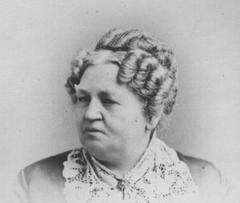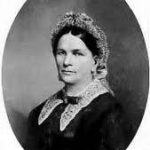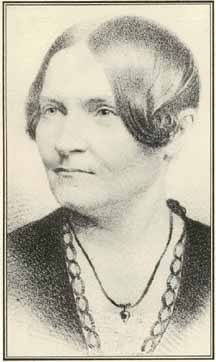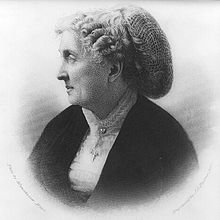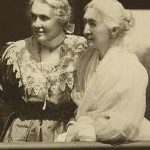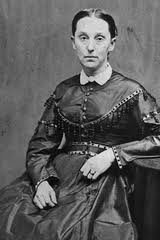Feminist Author and Women’s Rights Activist
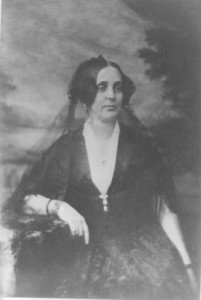 Elizabeth Oakes Smith (1806-1893) was a poet, novelist, editor, lecturer and women’s rights activist whose career spanned six decades. Today Smith is best known for her feminist writings, including “Woman and Her Needs,” a series of essays published in the New York Tribune between 1850 and 1851 that argued for women’s equal rights to political and economic opportunities, including the right to vote and access to higher education.
Elizabeth Oakes Smith (1806-1893) was a poet, novelist, editor, lecturer and women’s rights activist whose career spanned six decades. Today Smith is best known for her feminist writings, including “Woman and Her Needs,” a series of essays published in the New York Tribune between 1850 and 1851 that argued for women’s equal rights to political and economic opportunities, including the right to vote and access to higher education.
Early Years
Elizabeth Oakes Prince was born August 12, 1806, near North Yarmouth, Maine, to David and Sophia Blanchard Prince. After her father died at sea in 1808, her family lived with her maternal and paternal grandparents until her mother remarried and moved with her stepfather to Cape Elizabeth near the south coast of Maine, where she spent much time even after the family moved to Portland when she was eight.
An intensely precocious child, Elizabeth learned to read at the age of two by overhearing her older sister’s lessons in their home in Maine. In her autobiography, she recalls teaching in a Sunday School for black children at age twelve. She dreamed of going to college like her male cousins and running her own girls’ school, but at her mother’s insistence, Elizabeth married Seba Smith at the age of sixteen. Seba Smith was a thirty-year-old magazine editor and author of the popular Major Jack Downing stories.
Family
In Portland between 1824 and 1834 Smith bore six sons, Benjamin (1824), Rolvin (1825-1832), Appleton (1828-1887), Sidney (1830-1869), Alvin (1832-1902) and Edward (1834-1865), four of whom lived to adulthood. Thus for the first decade of her marriage, Smith managed a growing household, which at times included apprentices and printers in her husband’s newspaper ventures who boarded with them.
Smith began writing poems and sketches which appeared anonymously in her husband’s newspapers – The Eastern Argus and later the Portland Daily Courier. When her husband traveled to Boston in 1833 to supervise the publication of The Life and Writings of Major Jack Downing, she became editor of the Courier. By the late thirties, Smith had begun to contribute regularly to the newspapers her husband edited as well as magazines, anonymously or over the signature ‘E.’
Caught up in the fever of land speculation during the 1830s, her husband invested in a tract of land near Monson, Maine. When land values plummeted in the Panic of 1837, Smith lost much of his fortune. Smith wrote and later published Riches Without Wings, a moralist novel which targets the victims of the Panic and favors spiritual over material wealth.
Her husband attempted to recover his losses by backing an invention designed to clean Sea Grass Cotton. Smith traveled with her husband to Charleston, South Carolina, where the invention proved unsaleable, and where she was exposed to the reality of slavery for the first time.
Literary Career
In 1838 Smith and her husband moved their family to New York City, where they planned to make their living writing. On their arrival, Smith and her family boarded with cousins of the Princes, Dr. Cyrus and Maria Child Weeks.
In the summer of 1842 they moved to Brooklyn, where Elizabeth Oakes Smith emerged as a recognized name in the New York literary world. In their new home, both Smith and her husband contributed to literary magazines such as Godey’s Lady’s Book and Snowden’s Ladies’ Companion, among other journals and gift books.
Smith received her first wide literary notice with The Sinless Child, a long narrative poem published serially in the Southern Literary Messenger in January and February of 1842, and a first edition of her collected poems, The Sinless Child and Other Poems, was published by John Keese later that year.
Throughout the 1840s, she continued to write poetry and fiction for other popular magazines and gift books, but she also wrote two novels, The Western Captive, which appeared in a ‘supplement’ edition (the model of the early paperback novel) to Park Benjamin’s New World in 1842, and The Salamander, a highly allegorical story based on the history and legends of iron workers in the Ramapo Valley, in 1848.
Smith’s poems were reprinted as The Complete Poetical Writings of Elizabeth Oakes Smith by Rufus Griswold in 1845. She also edited the gift book The Mayflower in 1846-47, and published three volumes of children’s stories (The True Child, The Moss Cup and The Dandelion), all subtitled ‘stories not for good children, or bad children, but real children.’
In 1848, Putnam published her novel, The Salamander (later reprinted as Mary and Hugo), and acknowledged the ‘death’ of her pseudonym ‘Helfenstein’ in the preface to The Salamander, yet published occasionally under the name in later years as ‘the late Ernest Helfenstein.’
Women’s Rights Movement
Smith was not a member of the select group at the Seneca Falls Convention assembled to discuss the rights of women in 1848, but by that time she had for some years written occasionally on the subject of women’s social, political and economic situation. As she recorded in her autobiography, her attendance at the first National Women’s Rights Convention in October 1850 in Worcester, Massachusetts, inspired her to focus her efforts specifically on woman’s rights.
Though dismissed by such leaders as Susan B. Anthony for her fancy dress and traditional, feminine appearance, Smith began a series of ten articles on women’s rights and capacities for Horace Greeley’s New York Tribune entitled Woman and Her Needs (November 1850 – June 1851), published in pamphlet form by Fowler and Wells in late 1851.
In June 1851, she began lecturing publicly on the same subjects in New York and New England, becoming the first woman to lecture regularly on the Lyceum movement circuit. In 1852, her tours extended west to Cincinnati, St. Louis and Chicago. In September of that year, she was nominated by a select committee to serve as President of the National Women’s Rights Convention in Syracuse but was rejected for that position when she arrived in a dress that exposed her neck and arms.
Smith circulated a prospectus for a feminist journal, The Egeria, soliciting $500 in support and fifty subscribers, but she abandoned the idea when fellow activist Paulina Wright Davis began The Una in February 1853. Lecture tours through New England, Pennsylvania, New York and Ohio, and attendance at yearly Woman’s Rights Conventions continued through the 1850s.
In 1854, Smith published two novels, Bertha and Lily; or the Parsonage at Beech Glen, which presented many of her women’s rights positions (sometimes drawn directly from her lectures), and The Newsboy, a novel which exposed the conditions of homeless children and child labor in New York.
In addition to these extended works, both of which were reprinted in several editions, Smith edited and contributed to several of her husbands new ventures in journalism, including The Weekly Budget (1853-54) and a series of newspaper ventures combined in the mid-fifties under the title Emerson’s Monthly and United States Magazine.
In 1855, Smith and her family moved back to New York City, putting a down payment of $11,000 on a home near St. Mark’s Place. In November 1858, Smith and her family purchased Emerson’s Monthly, which continued for a year as The Great Republic, published by Oaksmith and Company. (From this time, and perhaps earlier, her sons legally adopted Oaksmith as their surname.)
In 1860, Smith and her husband retired to a large home in rural Patchogue, Long Island, which they named ‘The Willows’ – one of the largest houses in Patchogue, complete with billiard room and aviary. Seba Smith was suffering from hearing loss and embarrassment over his condition prevented him from making friends in town.
At the beginning of the Civil War, Elizabeth Oakes Smith addressed the Union troops at a small pageant near her home in October 1861, and contributed cloaks and mittens for the Union soldiers.
Appleton’s Arrest
During the 1850s, Smith’s son Appleton Oaksmith had ventured into the shipping business, eventually purchasing several ships of his own. He was also involved in the military campaigns of General William Walker, an American physician, lawyer and adventurer, who had organized several private military expeditions into Latin America with the intention of establishing English-speaking colonies under his personal control, an enterprise then known as ‘filibustering.’
Walker became president of Nicaragua in 1856, and Appleton Oaksmith accepted the office of secretary in Walker’s new ‘government’ and helped arrange for the supply of Walker’s small military force. When Walker’s bid for U.S. recognition failed and his militia was ousted from the country, and Walker was executed by the government of Honduras in 1860.
There is evidence that Appleton Oaksmith began to use his ships to support the Confederate states, at least in gun-running if not by allowing his ships to be used in the transport of slaves. In December 1861, Oaksmith was captured on Fire Island, New York, and indicted for equipping a slave ship. President Abraham Lincoln had suspended habeas corpus, and Oaksmith he was quickly jailed, and the entire family was placed in a compromised political and social position.
Therefore, the Civil War years were especially difficult for Smith’s family, who vehemently maintained Appleton’s innocence. Elizabeth Oakes Smith spent years seeking audiences with government officials in New York and finally with the President of the United States to procure her son’s innocence. (He later received a Presidential pardon.) With her husband advancing in age and infirmity, she continued to write to make a living, placing her work in a variety of journals and lecturing where she could.
Visiting friends in New York, Smith was caught in a draft riot in July 1863, and later recorded the experience in her diary. With the nation’s attention focused on the war and issues of slavery, her popularity and prominence waned, but in 1865 she began a series of ‘Autobiographic Notes’ in Beadle’s Monthly Magazine, later continued in The Home Journal.
Challenged and stigmatized by Appleton’s exile to London during the war (whom she visited there), Smith continued to seek aid from Gerrit Smith, Thurlow Weed and others to have Appleton pardoned. She experienced more misfortune before the end of that difficult decade with the loss of her son Edward to yellow fever in 1865, her husband Seba Smith’s passing on July 29, 1868, and the death of her son Sidney at sea in 1869.
Living in dire financial straits, she sold her home ‘The Willows’ in Patchogue in 1870 and began living with her son Alvin Oaksmith in nearby Blue Point, Long Island. Smith donated a selection of books to the Bowdoin Library and the Portland Historical Society, but was forced to sell much of her personal library.
Late Years
When Appleton returned to the United States in the 1870s, he purchased a property in Beaufort, North Carolina. In 1874, Smith sailed for Beaufort to visit Appleton and lost almost all her possessions in a shipwreck. Undaunted by her reverses, she continued to publish poetry and articles in both popular and religious journals.
In 1877, she served as pastor of The Independent Church in Canastota, New York. As fragments of her personal journal from the late 1880s demonstrate, Smith turned increasingly to a traditional religious faith in her later years.
Continuing to attend conventions on women’s suffrage, in January 1879, she delivered a lecture entitled ‘Biology and Woman’s Rights’ at the 11th Woman’s Suffrage Convention, in Washington, DC.
Spending summers with Alvin in Blue Point and winters with Appleton in Beaufort, Smith wrote much of her autobiography, A Human Life, between 1881 and 1885. Son Appleton died in 1887.
Although editors at The Home Journal advertised her autobiography as near completion, it was never published. Smith wrote in her journal that she was ashamed to see so much of this writing reflect not her life but ‘the promise of her childhood.’ Frustrated, she burned large quantities of correspondence.
She outlived all of her immediate family except her youngest son Alvin. By the time of her death her fictional works had suffered the fate of all outmoded popular styles and themes, while her feminist works would have to await the renewed interest of activists and scholars in the 1970s and 80s.
Elizabeth Oakes Smith died on November 15, 1893, after a short illness in Beaufort, North Carolina. She was buried beside her husband Seba and son Edward in Lakeview Cemetery in Patchogue, Long Island.
Most well- known at the start of her professional career for her poem The Sinless Child, her reputation today rests on her feminist writings, including Woman and Her Needs, a series of essays published in the New York Tribune between 1850 and 1851 that argued for women’s spiritual and intellectual capacities as well as women’s equal rights to political and economic opportunities, including rights of franchise and higher education.
Smith became widely known because of her abolitionist support and her views on marriage. Although there is no proof that her marriage was unhappy, much of her feminist success came from her liberal view of marriage. She believed women had the right to develop fully as individuals, and that the current constraints of the marriage relationship inhibited their development. This was articulated in a series of essays under the title Woman and Her Needs.
Excerpt from Woman and Her Needs No. II, November 30, 1850:
Men have written for us, thought for us, legislated for us; and they have constructed from their own consciousness an effigy of a woman to which we are expected to conform. It is not a Woman that they see, God forbid that it should be; it is one of those monsters of neither sex, that sometimes outrage the pangs of maternity, but which expire at the birth, whereas the distorted image to which men wish us to conform, lives to bewilder, to mislead and be misled, and to cause discord and belittlement where the Creator designed the highest dignity, the most complete harmony.
Men have said we should be thus and thus, and we have tried to be in accordance because we are told it is womanly. They have said we must think in a certain way; and we have tried so to think; they have said that under given circumstances we must act after a particular mode, and we have thus acted – ay! even when the voice of God in our own hearts has called out ‘where art thou?’ and we have hid ourselves, not daring to reply, for with that cowardice which men tell us is feminine, we dared not face that public opinion which men have established; dared not encounter that ridicule which men first start, and weak women follow up – dare not face that isolation which great and true thought brings upon itself in the present pettiness and prejudice of the world.
SOURCES
Wikipedia: Elizabeth Oakes Smith
Elizabeth Oakes Smith (1806 – 1893)
